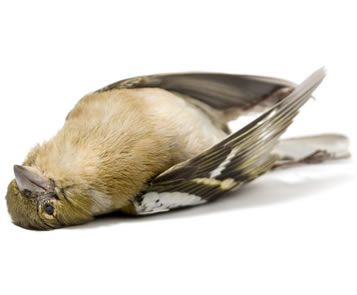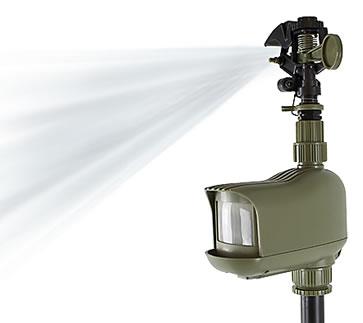





Cats
How to Repel Cats
Keeping unwanted cats out of your yard and preventing damage is possible with an integrated repelling plan. Below, Havahart® provides step-by-step instructions teaching you how to use repellents to stop cats from using your yard as a litter box and from causing damage to your trees, grass and plantings.
1 Identify Areas of Damage
Locate the damage caused by the cats in your yard. Because each repelling method works a bit differently, doing so will help you to select the most effective repellent(s) for you.

Common cat activities include:
- pilfering garbage
- using your garden as a litter box
- urinating on your lawn
- mating/yowling in your yard
- spraying/urine-marking on vertical surfaces
- scratching tree bark
- preying on birds
- nesting underneath your porch or other structure
2 Choose Your Cat Repellent
Once you've located your problem areas, use the information below to choose the best repellent solution for you. Cats are very habitual by nature, which means they may require several forms of discouragement in order to be successfully repelled. For the best long-term results, use multiple repellents at once.
Liquid Spray Repellents
Best For: Preventing cats from digging in your garden, scratching at trees and eating your plants or garbage. Spray liquid repellents directly onto outdoor surfaces that you want to protect, such as:

- garbage cans
- grass
- trash bags
- trees
- soil
- shrubs
- mulch
- other plants
TIP: Select a repellent that contains pepper-based ingredients, which provide two layers of protection by irritating a cat's sense of smell and taste.
Shop Liquid Repellents »Granular Repellents

Best For: Creating a repelling barrier to keep cats out of entire protected areas. Sprinkle granular repellents around the perimeters of indoor and outdoor areas, such as:
- yards
- porches
- gardens
- barns
- flowerbeds
- garages
- lawns
- houses
TIP: Apply granules in areas that you do not want cats to cross, like entrances or pathways. You may also use granular repellents to spot-treat patches of lawn or gardens that cats may frequent.
Shop Granular Repellents »Electronic Repellents
Best For: Frightening cats with sudden bursts of water, and conditioning them to stay away from virtually any area, such as:

- vegetable gardens
- plants
- mulch beds
- pathways
- flowerbeds
- pool areas
- yards/lawns
- structures
- koi ponds
- entryways
- garbage cans
- trees
TIP: Most cats hate being sprayed with water, which makes a motion-activated sprinkler one of the best control options for cats. A few days after installing a motion-activated sprinkler, reposition it to make sure that neighborhood cats don't learn to avoid it. Soon they will associate the annoyance with your yard and learn to stay away.
Shop Electronic Repellents »3 Apply as Directed

The effectiveness of any animal repellent relies heavily on the way in which it is applied. It is essential that the user thoroughly understands the directions for use before applying. Steps to remember include:
- Repellents must be reapplied periodically in order to maintain full repellency.
- Liquid repellents should only be applied in dry weather, in temperatures over 40° F.
- Granules should be sprinkled at the rate (amount of granules per square foot) indicated on the back panel to ensure effectiveness.
- Location is key when setting up electronic repellents - sensors and sprinkler should be pointed in the direction animals are approaching.
4 Remove Attractants

The absence of cat attractants in your yard is critical to your repelling plan - specifically sources of food and shelter. Important steps to take include:
- Remove trash and secure garbage bins. Human scraps are among the top food sources for feral cats.
- Clean up any leftover food, drinks or pet food.
- Avoid feeding cats or other wild animals on your property.
- Control rodents (on which cats prey) in and around your home.
- Prohibit access to dry, covered spaces such as porches, sheds, garages and other structures.
TIP: Maintain your home and yard often to keep cats away long-term.
Expert Tips
- Because cats need a lot of discouraging to be repelled from your yard, the best repellents deter cats by targeting both senses of scent and taste. Look for repellents with pepper-based ingredients that are proven to repel cats in this way.
- One of the most common food sources for feral cats is garbage - spray your trash bags as well as waste containers frequently to deter feral cats from dining on your garbage and send them searching for food elsewhere.
- Install several electronic repellents around the perimeter of your yard to keep cats out. Electronic repellents can be much more economical and convenient than traditional repellents, because you only need to purchase them once, and there is no need to reapply.
- Reinforce your garden repellents by planting some cat-resistant plant varieties, such as rue or lavender
- While applying cat repellents and reducing attractants will help to keep cats out of your yard, you may also choose to take actions to control the stray or feral cat population in your area. Learn about the other cat control methods by reading How To Get Rid of Cats »
